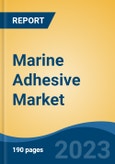Speak directly to the analyst to clarify any post sales queries you may have.
10% Free customizationThis report comes with 10% free customization, enabling you to add data that meets your specific business needs.
Key Market Drivers
Growing Demand from Marine or Construction Industry is Major Factor for Marine Adhesive Market Growth
The rising demand from the marine and construction sectors is a primary catalyst for the global marine adhesive market. With global construction output forecasted to increase from USD 9.7 trillion in 2022 to USD 13.9 trillion by 2037, countries like China, India, and the U.S. are heavily investing in infrastructure and urban development. Within the marine sector, adhesives are increasingly used in shipbuilding and repair, offering advantages such as strong bonding to diverse substrates, resistance to corrosion, and enhanced durability. These adhesives are preferred for applications including structural bonding, sealing, and insulation across vessels like commercial ships, naval vessels, and recreational boats. Their contribution to weight reduction and improved fuel efficiency aligns with evolving industry standards and performance expectations, supporting continued market expansion.Key Market Challenges
Harsh Environmental Conditions
One of the primary obstacles for the marine adhesive market is the need to withstand harsh environmental conditions. Marine environments expose adhesives to continuous saltwater contact, extreme temperatures, UV radiation, and mechanical stress, all of which can compromise bond integrity over time. Saltwater corrosion, in particular, poses a threat to both the adhesive and the substrates it bonds, while fluctuating temperatures and prolonged UV exposure can lead to degradation. These conditions necessitate frequent maintenance, increase operational costs, and challenge manufacturers to engineer solutions that offer long-term reliability. Advanced formulations incorporating anti-corrosive properties, flexible polymers, and robust curing mechanisms are in development to address these challenges and maintain adhesive effectiveness in demanding marine applications.Key Market Trends
Development of New Marine Adhesives with Improved Performance Characteristics
A significant trend shaping the marine adhesive market is the innovation of adhesives with enhanced capabilities tailored to evolving industry requirements. As marine applications increasingly involve diverse substrates and operate in severe conditions, demand is growing for adhesives that exhibit high bonding strength, rapid curing, and resistance to moisture, corrosion, and mechanical stress. The trend includes the development of adhesives suitable for underwater or submerged conditions, supporting repairs and structural reinforcements without compromising performance. Formulations designed for bonding dissimilar materials are also gaining prominence, enabling secure adhesion between metals, plastics, and composites. These innovations cater to shipbuilding, offshore infrastructure, and niche marine applications, reinforcing the importance of R&D in expanding the scope and reliability of marine adhesives.Key Players Profiled in this Marine Adhesive Market Report
- 3M Company
- Bostik SA
- Gurit AG
- H.B. Fuller Company
- Henkel AG & Co. KGaA
- Huntsman International LLC (Huntsman Corporation)
- Illinois Tool Works
- Parson Adhesives Inc.
- Scott Bader Company Ltd.
- Sika AG
Report Scope
In this report, the Global Marine Adhesive Market has been segmented into the following categories, in addition to the industry trends which have also been detailed below:Marine Adhesive Market, by Resin Type:
- Epoxy
- Silicon
- Polyurethane
- Acrylic
- Other
Marine Adhesive Market, by Application:
- Deck Systems
- Glazing
- Panel Bonding
- Others
Marine Adhesive Market, by Substrate:
- Plastic
- Composite
- Metals
- Others
Marine Adhesive Market, by End Use:
- Cargo Ships
- Passenger Ships
- Boat
- Other
Marine Adhesive Market, by Region:
- Asia-Pacific
- China
- India
- Japan
- Australia
- South Korea
- North America
- United States
- Canada
- Mexico
- Europe
- France
- United Kingdom
- Italy
- Germany
- Spain
- South America
- Brazil
- Argentina
- Colombia
- Middle East & Africa
- South Africa
- Saudi Arabia
- UAE
- Egypt
Competitive Landscape
Company Profiles: Detailed analysis of the major companies present in the Global Marine Adhesive Market.Available Customizations
With the given market data, the publisher offers customizations according to a company's specific needs. The following customization options are available for the report.Company Information
- Detailed analysis and profiling of additional market players (up to five).
This product will be delivered within 1-3 business days.
Table of Contents
Companies Mentioned
The leading companies profiled in this Marine Adhesive market report include:- 3M Company
- Bostik SA
- Gurit AG
- H.B. Fuller Company
- Henkel AG & Co. KGaA
- Huntsman International LLC (Huntsman Corporation)
- Illinois Tool Works
- Parson Adhesives Inc.
- Scott Bader Company Ltd.
- Sika AG
Table Information
| Report Attribute | Details |
|---|---|
| No. of Pages | 184 |
| Published | May 2025 |
| Forecast Period | 2024 - 2030 |
| Estimated Market Value ( USD | $ 474.61 Million |
| Forecasted Market Value ( USD | $ 564.33 Million |
| Compound Annual Growth Rate | 3.0% |
| Regions Covered | Global |
| No. of Companies Mentioned | 11 |









